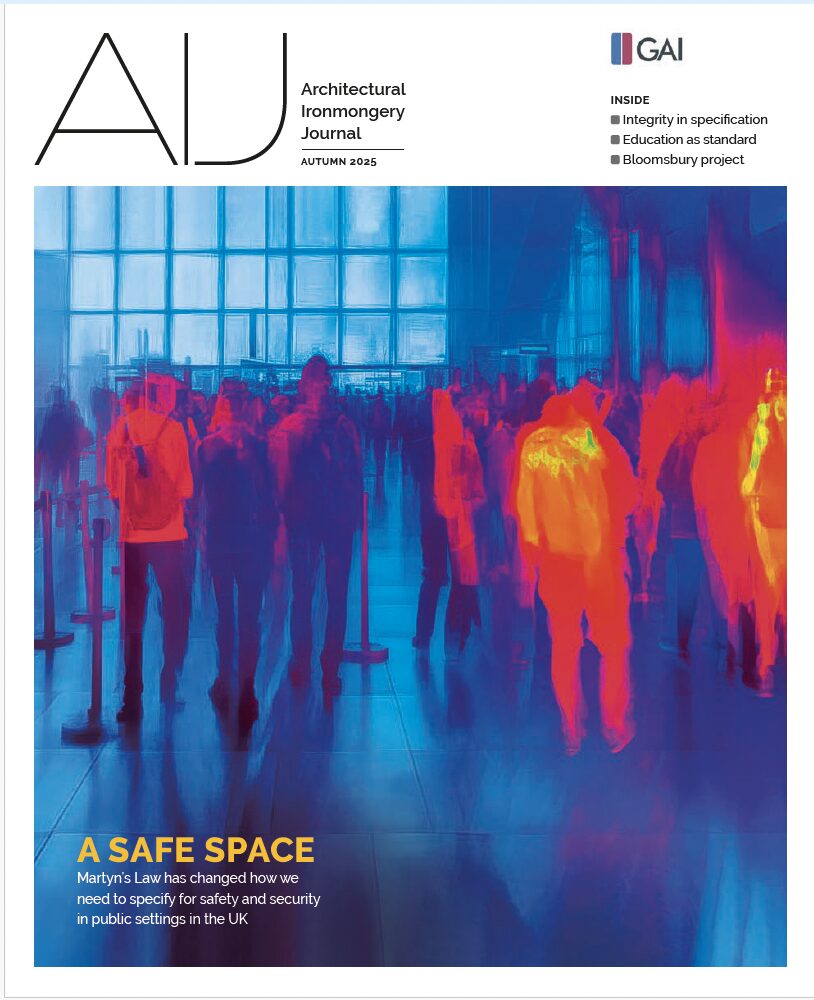
Martyn’s Law has changed how we specify for safety and security in public spaces in the UK. Douglas Masterson reports on the impact for architectural ironmongers
On the evening of 22 May 2017, an improvised explosive device was detonated in the foyer of Manchester Arena as crowds left a pop concert. Tragically, 22 people were killed and hundreds more injured. This event reshaped how the UK thinks about security in public spaces. It highlighted the consequences of vulnerabilities in venue security and the devastating impact of a lack of preparedness. A subsequent public inquiry examined the circumstances of the attack in detail and made a series of recommendations to improve preparedness and protective security, many of which directly informed the development of new UK legislation.
Among the many legacies of that night is Martyn’s Law – formally the Terrorism (Protection of Premises) Act 2025 – named after Martyn Hett, one of the 22 victims. The law aims to embed a culture of preparedness and proportionate protective security measures in venues and public spaces across the UK. For those in the security and built environment industries, particularly architectural ironmongers and hardware specialists, the legislation brings both new responsibilities and opportunities to contribute directly to public safety.
Martyn’s Law emerged from the campaigning of Figen Murray (Martyn’s mother), who argued that many public venues were ill-prepared for terrorist incidents. Her efforts, supported by survivors and security experts, persuaded the UK Government to introduce legislation designed to raise baseline security standards across the country.
The key principle underpinning this law is proportionality: requirements will vary according to the size of a venue and the type of activities taking place. For example, a small community hall should not be expected to implement the same level of security as a football stadium, but both should demonstrate some level of preparedness and resilience against attack.
Buildings and venues in scope
Martyn’s Law applies primarily to publicly accessible buildings and venues above certain capacity thresholds. The Act categorises premises according to size, use, and risk profile. Examples of in-scope buildings include:
- Entertainment and leisure venues: theatres, concert halls, cinemas, nightclubs, arenas, and stadiums.
- Retail and hospitality: shopping centres, large retail stores, pubs, bars, restaurants, hotels, and conference centres.
- Public and community buildings: town halls, libraries, community centres, and places of worship.
- Education establishments: schools, colleges, and universities, depending on size and public access.
- Health and transport hubs: hospitals, railway stations, and airports.
- Outdoor events: festivals, fairgrounds,
and temporary structures with controlled entry points.
- l Generally, private dwellings, small businesses, and workplaces not open to
the public will be out of scope.
- Capacity-based tiering in relation to the building or project will ensure proportionate requirements in relation to security:
- Standard Tier (200–799 capacity):
Premises in this tier will be required to undertake basic but essential steps to improve preparedness. These focus on simple, low-cost activities designed to reduce harm and save lives in the event of an attack—such as locking doors, closing shutters, and identifying safe routes to cover. There is no requirement to implement physical security
measures at this level.
- Enhanced Tier (800+ capacity):
Larger venues and those considered higher risk will face more stringent obligations. They will need to conduct detailed risk assessments, implement robust security measures (procedural and physical), and demonstrate compliance through regulatory inspections.
In both tiers, the emphasis is on proportionate, practical measures rather than unnecessary bureaucracy. Compliance will, however, be enforceable, with
penalties for failure.

Although Martyn’s Law received Royal Assent on 3 April 2025, it is not yet in force. The Government has deliberately built in an implementation period of at least 24 months to give both regulators and industry time to prepare. The earliest realistic date for the law to take effect will be April 2027.
During this transitional phase the Security Industry Authority (SIA) will establish its role as the regulator responsible for overseeing compliance. Venue operators, building owners, and managers will need to review existing security arrangements and start aligning them with the proportional requirements of the Act.
Impact on ironmongery
For architectural ironmongery professionals, the next two years should be viewed as a time of preparation and positioning. Ironmongers, consultants, and manufacturers have an opportunity to educate clients, refine product specifications, and build awareness of compliant solutions before enforcement begins. Practical steps include:
Guidance: Begin conversations with clients about their venues’ size, function, and likely classification (Standard or Enhanced Tier).
Product Readiness: Review ranges of locks, panic hardware, and access control systems to ensure certification and compliance with both safety and security standards.
Training: Ensure teams are trained to advise competently on balancing egress, accessibility, and security.
Partnerships: Build stronger links with architects, security consultants, and venue operators to become trusted advisors.
Martyn’s Law will inevitably shape how ironmongery is specified in both new build and retrofit projects. Security considerations will now carry greater weight alongside fire safety, accessibility, and aesthetics. Specifiers will increasingly need to:
- Select certified and tested products
that demonstrate resilience against forced entry while meeting fire, escape, and accessibility requirements.
- Consider access control and flow management. For enhanced-tier venues, controlling access is central to deterrence and response. Ironmongers will play a significant role as locking devices, panic hardware, and access systems must balance emergency egress with security.
- Focus on the importance of compartmentalisation as part of security strategies, ensuring doors and barriers both guide evacuation and create safe refuge areas.
- Specify door hardware carefully in respect of emergency egress. Martyn’s Law does not exist in isolation—it must align with fire safety, building regulations, and accessibility. For example:
- Panic devices must allow rapid evacuation while resisting forced entry, and comply with standards such as BS EN 1125 (panic escape), BS EN 179 (emergency escape), and BS EN 13637 (electrically controlled exit systems).
- Integration with alarms and security systems will be crucial, ensuring that in a hostile incident, doors behave as intended to aid evacuation or lockdown.
Ironmongery professionals should also:
- Prioritise third-party certification. With accountability already strengthened post-Grenfell, Martyn’s Law will increase demand for certified, traceable, tested products. Suppliers must provide documentation to clients that may be required during inspections.
- Assist with operational preparedness and training. The law is not only about physical measures – people and processes matter. Advising on intuitive hardware, supporting training, and ensuring usability under stress are all vital.
- Advise on retrofit and legacy buildings. Many affected venues will be existing
rather than new. Retrofitting hardware
that balances proportionality, compliance, and heritage constraints will be key.
This may include:
- Upgrading mechanical locks to electronic access systems where appropriate.
- Adding controlled exit devices that delay attackers without impeding life safety (noting these must be tested to BS EN 13637 and approved by Building Control).
- Reconciling heritage considerations with modern security needs.
Finally, working closely with facilities managers (FMs) will be essential. FMs will be on the front line of implementing Martyn’s Law, ensuring safety, resilience, and compliance within the built environment. They will look to trusted suppliers for practical, compliant solutions.
Get educated
Education environments illustrate how Martyn’s Law will be applied. Schools and colleges often accommodate large numbers of people across multiple buildings, with open access during the day but tighter security required at other times. Under Martyn’s Law:
- Risk assessments must consider arrival/departure peaks, visitor access, and after-hours community use.
- Access control hardware such as electronic locks, secure entry points,
and access control systems will be increasingly important.
- Emergency egress must remain straightforward for pupils and staff, while lockdown capability may also be required during hostile incidents.
- Staff training will be critical, ensuring teachers and administrators know
how to operate door systems and
respond in a crisis.
- For ironmongery professionals, this presents an opportunity to specify and supply tested solutions that balance everyday usability with enhanced security readiness.
“While Martyn’s Law poses compliance challenges it also represents an opportunity to demonstrate leadership”
Opportunity to lead
While Martyn’s Law poses compliance challenges, it also represents an opportunity for the architectural ironmongery industry to demonstrate leadership. By engaging early with clients, architects, and security consultants, ironmongers can position themselves as trusted advisors in achieving compliance. They can highlight the role of hardware in wider security solutions and innovate in product design to meet demand for secure, user-friendly solutions. The law will raise public awareness of physical security, making it easier for professionals to explain why investment in quality hardware is essential rather than optional.
Martyn’s Law is a landmark piece of legislation that will reshape how public venues approach security. For the architectural ironmongery and security industries, it signals a shift towards more integrated, accountable, and proportionate risk management. The challenge is to balance accessibility, life safety, and hostile threat resilience in addition to other key factors such as fire. For those who specify, supply, and maintain door hardware and access systems, this is both a responsibility and an opportunity: a chance to play a direct role in creating safer public spaces and honouring the legacy of Martyn Hett and all those affected by the Manchester Arena attack.
A Technical Briefing on this topic is available on www.gai.org.uk/knowledge. An online quiz based on this feature is available on the GAI Learning Hub. Completion of this quiz is worth one CPD point towards Registered Professional status. learninghub.gai.org.uk/totara/dashboard/index.php








